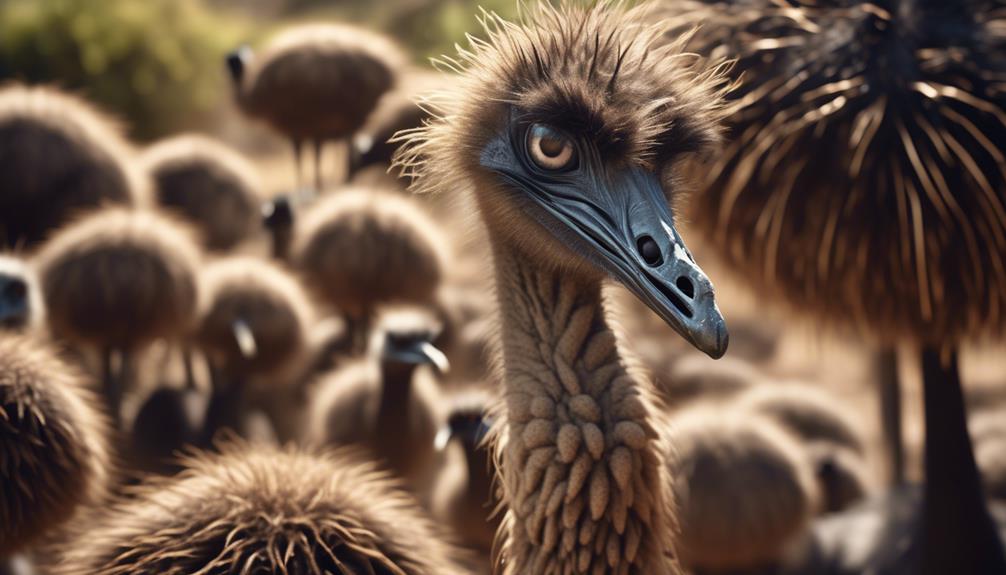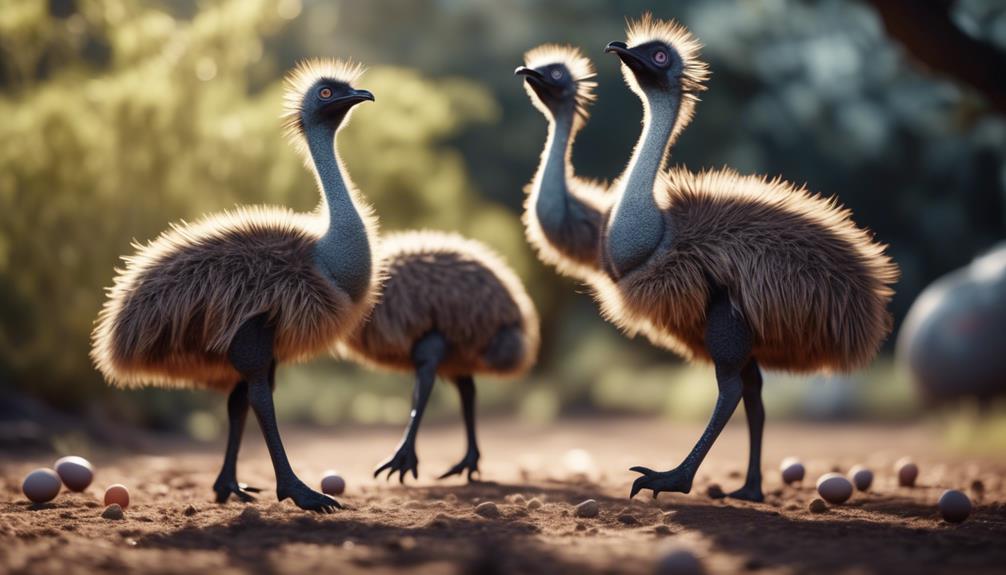
When it comes to comparative anatomy, exploring the differences between emus and other flightless birds is like embarking on a captivating journey through the animal kingdom. From their skeletal structure to their sensory organs, these fascinating creatures possess unique adaptations that set them apart from their flying counterparts.
But what sets emus apart from other flightless birds? What secrets lie within their muscular system, digestive system, respiratory system, and reproductive system? Prepare to uncover the intriguing mysteries of emus and discover why they are truly one of nature's most remarkable creations.
Key Takeaways
- Emus have long, sturdy legs and well-developed leg muscles for powerful strides, while other flightless birds have shorter and stockier legs with different muscular adaptations.
- Emus have a long, muscular esophagus and crop for storing and processing food, while other flightless birds like ostriches have a gizzard for mechanical breakdown of tough plant material.
- Emus have multiple air sacs for efficient gas exchange in their respiratory system, while other flightless birds like ostriches and kiwis have evolved different respiratory mechanisms.
- Flightless birds, including emus, have sensory adaptations such as excellent eyesight, powerful hearing abilities, and a sense of smell to enhance their hunting strategies in their respective environments.
Skeletal Structure
The skeletal structure of emus differs significantly from that of other flightless birds, showcasing unique adaptations for their terrestrial lifestyle. Evolutionary adaptations have shaped the emu's skeletal system to enable efficient locomotion mechanisms on land. One key feature is their long, sturdy legs, which provide a strong foundation for their body weight and allow for swift running. The femur, or thigh bone, is particularly elongated and robust, allowing for powerful strides and maximizing energy efficiency. In comparison, other flightless birds, such as penguins or ostriches, have shorter and stockier legs, reflecting their different locomotion requirements.
Furthermore, emus possess a specialized pelvic girdle, which supports their abdominal organs and provides stability during movement. The pelvis is characterized by a broad and robust structure, allowing for the attachment of powerful leg muscles. This adaptation enhances the emu's ability to generate forceful leg movements, enabling them to cover large distances quickly. In contrast, flightless birds that are more adapted for aquatic environments, like penguins, have a narrower and less robust pelvis, suited for swimming rather than land-based locomotion.
These evolutionary adaptations in the skeletal structure of emus have allowed them to thrive in their terrestrial habitat. Their long legs and specialized pelvic girdle provide the necessary support and power for efficient locomotion on land, distinguishing them from other flightless birds with different ecological niches. Understanding these unique skeletal adaptations contributes to our knowledge of how organisms have evolved to suit their environments.
Muscular System
Evolutionary adaptations in the skeletal structure of emus haven't only influenced their locomotion mechanisms, but also have significant implications for their muscular system. When it comes to the muscular system, emus exhibit unique features that enable them to run with great speed and endurance.
One important aspect of the muscular system is muscle fiber composition. Emus possess a high proportion of Type II muscle fibers, also known as fast-twitch fibers. These fibers contract rapidly, generating powerful and explosive movements. This composition allows emus to generate the force required for their swift running.
In addition to muscle fiber composition, emus have developed specific muscular adaptations for running. Their leg muscles, particularly the thigh and calf muscles, are well-developed and robust. These muscles provide the necessary power and stability during each stride, enabling emus to maintain their speed and agility.
Furthermore, emus have strong abdominal muscles that work in conjunction with their leg muscles. This muscular coordination allows for efficient energy transfer and helps maintain balance while running.
In comparison, other flightless birds, such as ostriches and kiwis, have different muscular adaptations. Ostriches, for example, have highly developed thigh muscles, but their calf muscles are relatively smaller. This difference in muscular morphology reflects the distinct locomotion strategies employed by each bird species.
Digestive System

Comparing the digestive systems of emus with those of other flightless birds reveals distinct anatomical adaptations that contribute to their respective feeding strategies. These evolutionary adaptations have played a crucial role in shaping the dietary preferences of these birds.
Emus, like other flightless birds, have a unique digestive system that allows them to consume and digest a wide variety of plant materials. Their long, muscular esophagus and crop enable them to store and process large amounts of food, which is particularly beneficial in their natural habitats where food can be scarce. Additionally, emus possess a specialized glandular stomach known as the proventriculus, which secretes digestive enzymes to break down complex carbohydrates and proteins.
Unlike emus, some flightless birds, such as ostriches and kiwis, have a different set of adaptations in their digestive systems. Ostriches, for example, have a remarkable gizzard that aids in the mechanical breakdown of tough plant material. This muscular organ grinds the food using swallowed stones, allowing for better nutrient extraction.
Kiwis, on the other hand, have a relatively simple digestive system, reflecting their insectivorous diet. They lack a crop and instead have a short, straight gut that facilitates the rapid digestion of small invertebrates.
Respiratory System
Emus, ostriches, and kiwis display distinct adaptations in their respiratory systems, contributing to their diverse abilities to thrive in different environments. These flightless birds have evolved unique respiratory mechanisms that enhance their respiratory efficiency and enable them to meet the demands of their specific lifestyles.
| Emus | Ostriches | Kiwis | |
|---|---|---|---|
| Size | Large | Largest | Small |
| Habitat | Grasslands and open woodlands | Savannahs and grasslands | Forests and wetlands |
| Adaptations | Air sacs provide efficient gas exchange | Two functional lungs for rapid oxygen delivery | Unidirectional airflow for efficient respiration |
Emus, being the second-largest flightless bird, have evolved a respiratory system that allows efficient gas exchange. They possess multiple air sacs that enhance the exchange of oxygen and carbon dioxide, enabling them to extract more oxygen from each breath. Ostriches, being the largest flightless bird, possess two functional lungs that work in coordination, allowing for rapid oxygen delivery to their muscles during high-speed running. This adaptation enables them to maintain their extraordinary speed and endurance. On the other hand, kiwis, being small birds found in forests and wetlands, have evolved a unique unidirectional airflow system. This system, combined with their small size, allows for efficient respiration and oxygen uptake, enabling them to thrive in their habitat with limited oxygen availability.
Reproductive System

The reproductive system of flightless birds, such as emus, ostriches, and kiwis, exhibits distinct adaptations that are essential for successful reproduction in their respective environments.
One key aspect of breeding behavior in flightless birds is their elaborate courtship displays. Male emus, for example, perform a unique dance where they puff up their feathers, make booming sounds, and perform short runs to attract females. Ostriches, on the other hand, engage in a complex ritual of feather fluffing, wing waving, and vocalizations. These behaviors not only signal the readiness to mate but also establish dominance within the group.
When it comes to egg laying patterns, flightless birds also differ from their flying counterparts.
Emus and ostriches lay their eggs in communal nests, where multiple females contribute their eggs. This behavior helps protect the eggs from predators as the sheer number of eggs and adults makes it harder for predators to locate and attack the nest.
In contrast, kiwis are unique in that they lay the largest egg relative to their body size of any bird species. This adaptation allows kiwi eggs to contain a large yolk, providing ample nutrients for the developing chick.
Sensory Organs
Flightless birds, including emus, ostriches, and kiwis, possess sensory organs that have evolved unique adaptations to their particular environments. These adaptations are crucial for their survival and hunting strategies.
Here are three key evolutionary adaptations in the sensory organs of flightless birds:
- Eyesight: Flightless birds have excellent eyesight, allowing them to spot prey from a distance. Emus, for example, have large eyes positioned on the sides of their heads, giving them a wide field of vision. This adaptation helps them detect predators and potential food sources in their open grassland habitats.
- Hearing: Flightless birds have well-developed auditory systems that enable them to detect sounds over long distances. Ostriches, known for their powerful hearing, can pick up low-frequency sounds that are inaudible to humans. This adaptation allows them to detect approaching predators and communicate with other members of their group.
- Olfaction: While flightless birds may not have a keen sense of smell compared to some other animals, they still utilize their olfactory organs to some extent. Kiwis, for instance, have long, slender bills with nostrils at the tip, which they use to sniff out invertebrates in the forest floor. This adaptation helps them locate prey in their dark, forested habitats.
These evolutionary adaptations in the sensory organs of flightless birds enhance their hunting strategies and enable them to thrive in their respective environments.
Frequently Asked Questions
How Do Emus Differ in Skeletal Structure Compared to Other Flightless Birds?
Emus' skeletal structure differs from other flightless birds in various ways. Their adaptations include longer and stronger leg bones, reduced wing bones, and a flexible neck. Additionally, Emus have unique muscular adaptations that support their flightless lifestyle.
What Are the Unique Muscular Adaptations Found in Emus That Enable Their Flightless Lifestyle?
Emus have unique muscular adaptations that enable their flightless lifestyle. These adaptations allow them to overcome the challenges of not having wings, such as powerful leg muscles for running and a strong, flexible neck for balance.
Can Emus Digest Food Differently Than Other Flightless Birds?
Can emus digest food differently than other flightless birds? Yes, they have a unique digestive system that allows them to efficiently break down tough plant material, making them formidable eaters among their flightless peers.
How Do Emus Breathe Differently Compared to Other Flightless Birds?
When comparing the breathing of emus to other flightless birds, it is important to analyze the mechanism of respiration. Emus have a unique respiratory system that allows them to efficiently extract oxygen from the air, setting them apart from their counterparts.
Are There Any Distinct Reproductive Characteristics or Behaviors Specific to Emus Compared to Other Flightless Birds?
When comparing emus to other flightless birds, it is important to note their distinct reproductive cycles and nesting habits. Emus have unique behaviors and characteristics that set them apart from their counterparts.
Conclusion
In conclusion, the comparative anatomy of emus and other flightless birds reveals fascinating similarities and differences.
While their skeletal structure and muscular system show adaptations for terrestrial locomotion, their digestive and respiratory systems vary in efficiency.
For instance, a hypothetical case study could examine the reproductive system of emus and compare it to that of ostriches, highlighting the unique adaptations each species has developed.
This detailed and scientific comparison deepens our understanding of the evolutionary processes that have shaped these remarkable flightless birds.





